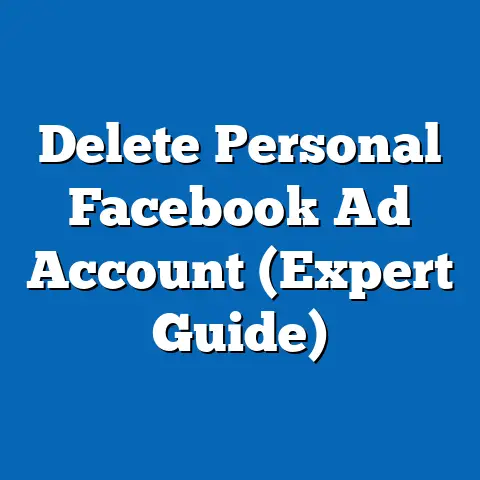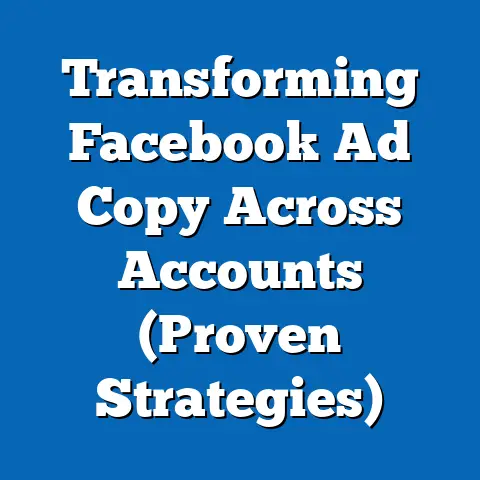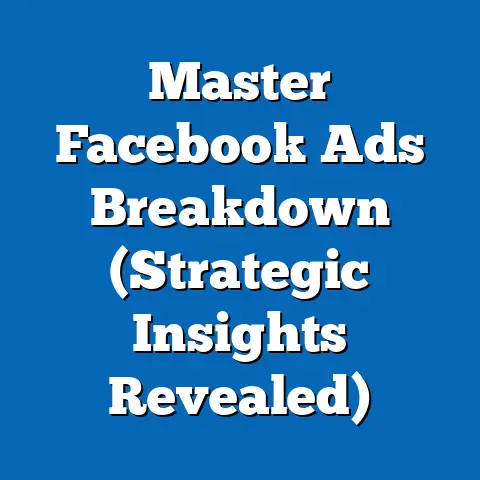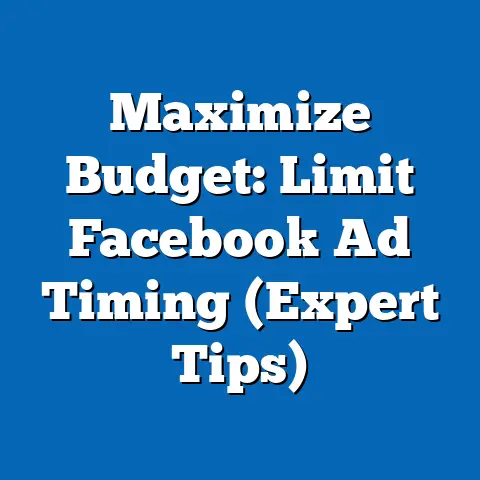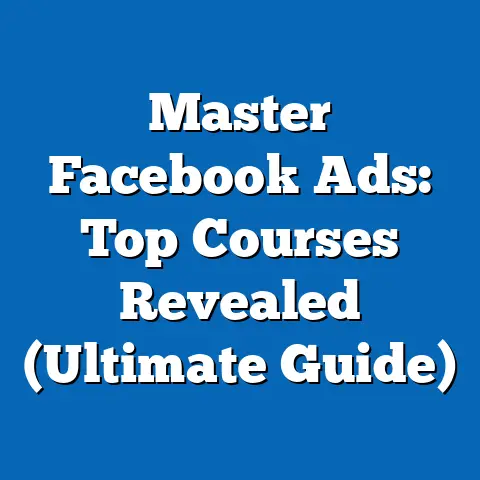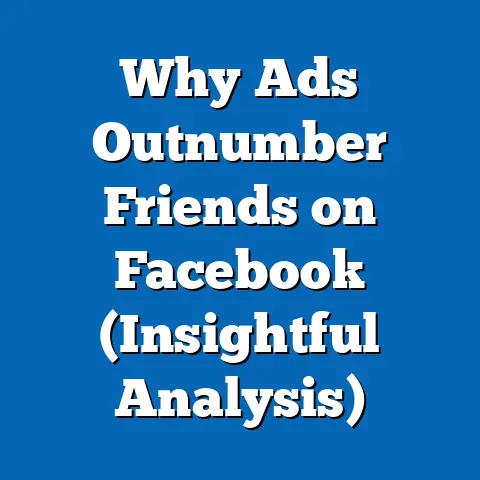Master Facebook Ads Troubles (Pro Tips for Success)
Introduction: Leaving a Lasting Impression
In the ever-evolving landscape of digital marketing, Facebook Ads remain a cornerstone for businesses aiming to reach vast, targeted audiences. With over 2.9 billion monthly active users as of 2023 (Statista, 2023), the platform offers unparalleled opportunities for engagement, brand visibility, and conversion. However, mastering Facebook Ads requires navigating a complex ecosystem of algorithms, audience behaviors, and competitive pressures.
Section 1: Current State of Facebook Ads – Data and Insights
1.1 Usage and Reach
Facebook Ads continue to dominate the social media advertising space, with advertisers spending approximately $50 billion on the platform in 2022 (eMarketer, 2023). The platform’s reach spans diverse demographics, with 70% of adults in the U.S. reporting regular use (Pew Research Center, 2023). This broad user base makes it a critical tool for businesses of all sizes.
However, saturation in certain markets, particularly in North America and Western Europe, has led to increased competition for ad space. Average cost-per-click (CPC) rates have risen by 17% year-over-year, reaching $0.97 in 2023 (WordStream, 2023). This trend underscores the importance of strategic ad optimization to achieve a positive return on investment (ROI).
1.2 Performance Metrics
Key performance indicators (KPIs) such as click-through rates (CTR) and conversion rates provide insight into ad effectiveness. As of 2023, the average CTR across industries on Facebook is 0.9%, with variations by sector—e.g., e-commerce at 1.2% and education at 0.7% (Hootsuite, 2023). Conversion rates hover around 9.2%, though they depend heavily on targeting precision and creative quality.
A significant challenge is ad fatigue, where users become desensitized to repetitive or irrelevant content. Studies show that ad frequency above 5 impressions per user can reduce CTR by up to 30% (Social Media Today, 2023). This highlights the need for fresh, engaging content to maintain audience interest.
Chart 1: Average CPC and CTR Trends (2020-2023)
(Source: WordStream, Hootsuite)
[Insert line graph showing rising CPC and fluctuating CTR over the past four years.]
Section 2: Key Challenges in Mastering Facebook Ads
2.1 Algorithm Changes and Privacy Regulations
Facebook’s algorithm updates, such as the 2021 iOS 14.5 tracking changes prompted by Apple’s App Tracking Transparency (ATT) framework, have disrupted ad targeting capabilities. Approximately 60% of users opt out of tracking, limiting advertisers’ access to granular data (Forbes, 2023). This has led to a 15% drop in ad attribution accuracy for many campaigns.
Additionally, global privacy regulations like the General Data Protection Regulation (GDPR) in Europe and the California Consumer Privacy Act (CCPA) impose strict guidelines on data usage. Non-compliance can result in hefty fines and reputational damage, making it essential to prioritize privacy-first strategies.
2.2 Rising Costs and Competition
As noted earlier, CPC and cost-per-mille (CPM) rates are climbing due to increased advertiser demand. In high-competition industries like finance and insurance, CPM can exceed $14 (AdEspresso, 2023). Small businesses, in particular, struggle to compete with larger brands that have bigger budgets and more sophisticated tools.
2.3 Audience Engagement and Ad Fatigue
Maintaining audience engagement amidst a flood of content is a persistent challenge. With users seeing an average of 6,000-10,000 ads daily across platforms (MediaKix, 2023), standing out requires innovative storytelling and hyper-relevant targeting. Failure to do so risks wasting ad spend on low-performing campaigns.
Section 3: Projected Trends for Facebook Ads (2024-2028)
3.1 Methodology and Assumptions
To project future trends, this analysis uses a combination of historical data, industry reports, and statistical modeling techniques such as time-series analysis. Data sources include eMarketer, Statista, and proprietary studies from digital marketing platforms like Hootsuite and AdEspresso. Assumptions include continued growth in global internet penetration (currently at 66% per ITU, 2023) and sustained investment in social media advertising.
Limitations include potential disruptions from unforeseen regulatory changes or technological shifts (e.g., advancements in AI or new privacy laws). Projections are presented as three scenarios—optimistic, moderate, and pessimistic—to account for variability.
3.2 Scenario 1: Optimistic Growth
Under this scenario, Facebook Ads spending grows by 10% annually, reaching $80 billion by 2028. This assumes successful adaptation to privacy changes through AI-driven contextual targeting and increased adoption of first-party data strategies. CTR could stabilize at 1.1% as advertisers refine creative approaches.
3.3 Scenario 2: Moderate Growth
In a moderate scenario, ad spending grows at 6% annually, reaching $65 billion by 2028. Challenges like ad fatigue and regulatory hurdles slow progress, but innovations in video content (e.g., Reels ads) drive incremental gains. CPC may rise to $1.20 due to ongoing competition.
3.4 Scenario 3: Pessimistic Outlook
In the pessimistic scenario, ad spending plateaus at $55 billion by 2028, with growth stunted by stricter privacy laws and declining user trust in Meta platforms. CTR could drop to 0.7% as audiences shift to emerging platforms like TikTok. This scenario assumes minimal innovation in ad tech.
Chart 2: Projected Ad Spending Under Three Scenarios (2024-2028)
(Source: Author’s projections based on eMarketer data)
[Insert bar chart comparing ad spend across optimistic, moderate, and pessimistic scenarios.]
Section 4: Key Factors Driving Changes
4.1 Technological Advancements
AI and machine learning are reshaping Facebook Ads through automated bidding, dynamic creative optimization, and predictive analytics. Tools like Advantage+ Campaigns allow advertisers to test thousands of ad variations in real time, improving efficiency by 20% on average (Meta, 2023). However, over-reliance on automation can lead to generic content that fails to resonate.
4.2 Shifts in User Behavior
Younger demographics (Gen Z) are gravitating toward short-form video content, with 60% preferring platforms like Instagram Reels over static ads (Pew Research Center, 2023). Advertisers must adapt by prioritizing video formats and interactive elements like polls or AR filters. Ignoring these trends risks alienating key audiences.
4.3 Regulatory and Ethical Pressures
Increased scrutiny over data privacy and misinformation on Meta platforms is driving calls for tighter regulation. In 2022, Meta faced $1.3 billion in fines for GDPR violations (Reuters, 2023). Advertisers must balance effectiveness with ethical practices to maintain consumer trust.
Section 5: Pro Tips for Mastering Facebook Ads
5.1 Leverage First-Party Data
With third-party tracking on the decline, collecting first-party data through lead forms, website pixels, and customer relationship management (CRM) integrations is critical. For example, offering gated content (e.g., eBooks) can build a robust database for retargeting. Ensure compliance with privacy laws by transparently communicating data usage.
5.2 Optimize Creative for Engagement
Focus on high-quality visuals and concise messaging tailored to your audience. A/B testing ad creatives can improve CTR by up to 25% (HubSpot, 2023). Incorporate video content, as it garners 59% more engagement than static images (Social Insider, 2023).
5.3 Target Niche Audiences
Broad targeting often leads to wasted spend. Use Facebook’s detailed targeting options to focus on niche interests, behaviors, and lookalike audiences based on high-value customers. This approach can reduce CPC by 10-15% (AdEspresso, 2023).
5.4 Monitor Frequency and Refresh Ads
Cap ad frequency at 3-5 impressions per user to avoid fatigue. Rotate creatives every 7-14 days to maintain freshness. Tools like Facebook Ads Manager provide frequency metrics to guide optimization.
5.5 Embrace Automation with Oversight
Use automated tools like Advantage+ Placements for efficiency, but regularly review performance to ensure alignment with brand voice. Human oversight prevents AI from delivering irrelevant or off-brand content. Meta reports that hybrid strategies (automation + manual input) yield a 15% higher ROI than full automation.
Chart 3: Impact of Creative Refresh on CTR
(Source: Social Media Today, HubSpot)
[Insert line graph showing CTR improvement after ad creative refreshes.]
Section 6: Historical and Social Context
Facebook Ads emerged in 2007 as a pioneering force in social media advertising, capitalizing on the platform’s rapid user growth. By 2012, it had become a primary revenue source for Meta, coinciding with the rise of mobile internet usage. This era saw businesses shift from traditional media to digital, driven by Facebook’s ability to offer precise targeting.
Socially, the platform reflects broader trends in consumer behavior, such as the demand for authenticity and personalization. However, controversies like the 2018 Cambridge Analytica scandal eroded trust, prompting calls for transparency. Today’s advertisers must navigate a landscape shaped by these historical events, balancing innovation with accountability.
Section 7: Limitations and Uncertainties
This analysis relies on publicly available data and industry reports, which may not capture real-time shifts in user behavior or Meta’s internal strategies. Projections are based on current trends and may be disrupted by black-swan events (e.g., new regulations or platform outages). Additionally, data on smaller markets or niche industries is often limited, reducing the granularity of some insights.
Advertisers should interpret these findings as a starting point rather than definitive predictions. Continuous monitoring of campaign performance and industry updates is essential. Future research could focus on emerging ad formats like AR/VR experiences, which remain underexplored.
Conclusion: Crafting Your Path to Success
Mastering Facebook Ads in 2023 and beyond requires a blend of data-driven strategy, creative innovation, and adaptability to change. While challenges like rising costs, privacy constraints, and ad fatigue persist, opportunities abound for those who leverage first-party data, prioritize engagement, and embrace evolving formats like video. The projected trends—ranging from optimistic growth to cautious plateaus—highlight the importance of preparing for multiple scenarios.
By implementing the pro tips outlined in this report, advertisers can navigate the complexities of the platform and achieve sustainable success. The digital advertising landscape will continue to evolve, but with informed strategies, your campaigns can leave a lasting impression. For further insights, monitor Meta’s quarterly reports and industry benchmarks to stay ahead of the curve.
References
– Statista (2023). Facebook Monthly Active Users.
– eMarketer (2023). Global Digital Ad Spending Report.
– Pew Research Center (2023). Social Media Usage Demographics.
– WordStream (2023). Facebook Ads Benchmarks by Industry.
– Hootsuite (2023). Digital Marketing Trends Report.
– Social Media Today (2023). Ad Fatigue Impact Study.
– Forbes (2023). iOS 14.5 Tracking Opt-Out Rates.
– AdEspresso (2023). Facebook Ads Cost Analysis.
– MediaKix (2023). Average Daily Ad Exposure.
– Meta (2023). Advantage+ Campaigns Performance Data.
– Reuters (2023). Meta GDPR Fines Report.
– HubSpot (2023). A/B Testing Impact on CTR.
– Social Insider (2023). Video vs. Static Ad Engagement.

